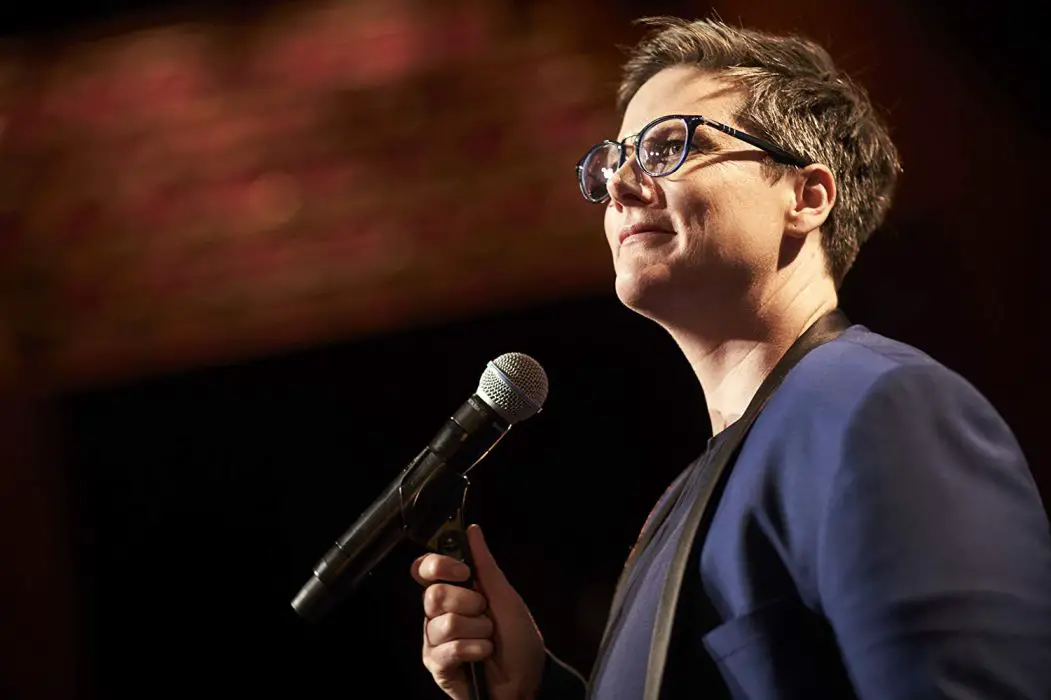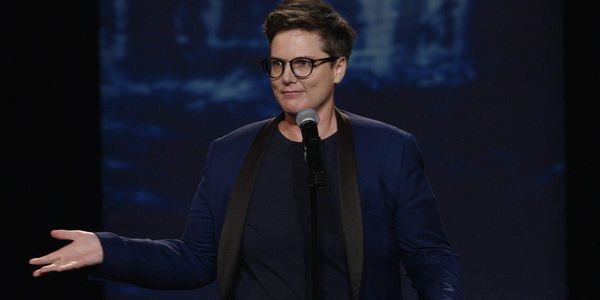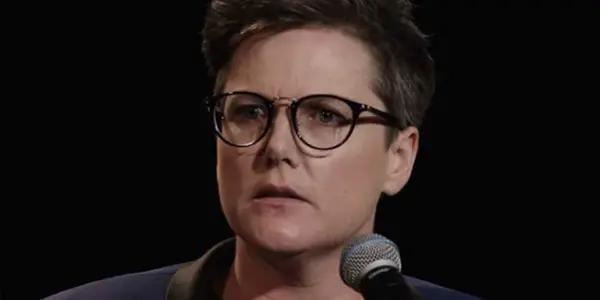Hannah Gadsby’s NANETTE Is A Film, Here’s Why

Jax is a filmmaker and producer, and a film &…
For some months now, fellow Film Inquiry writer Emily Wheeler and I have been casually debating at odds over a particular subject matter, indeed over one particular subject. In the spirit of good-natured pettiness, I’ve decided to make our little back and forth official.
It’s been just over a year since Hannah Gadsby’s groundbreaking special Nanette dropped on Netflix, propelling Gadsby into the mainstream and opening up a massive conversation about a range of subjects from gay and women’s rights to art history to the fundamentals of comedy. Now nominated for an Emmy, and with new special Douglas due out on Netflix in 2020, plenty has been written about the content of the comedy special Nanette; Gadsby herself has discussed it at length. However, something about the term “comedy special” or even just “special” (often implying stand-up or a one person show) feels inadequate. Gadsby delivers Nanette with not just a message, but a narrative, something more commonly described by another word when such a show is recorded – film.
How We Define Film
Perhaps it is prudent to backtrack slightly and first consider what, at its core, is required to make a film. Where does one separate a film from, say, simply a recording of a play? The most basic, dictionary definition offers that a film is “a story or event recorded by a camera as a set of moving images and shown in a cinema or on television.” David Bordwell and Kristin Thompson’s book Film Art: An Introduction starts with the premise that film has its own language and aesthetic. In brief, if one is looking to describe a piece of recorded media as a film, it should, by definition, have “a story or event” and additionally it should subscribe to the filmic language and aesthetic that has been established over the last hundred plus years.
The language and aesthetic (and indeed the definition of “story” and/or “event”), however, are mutable, as the various experimental movements of film have shown. For instance, Michael Snow’s Wavelength is simply a single shot of an empty room, failing to meet the “story of event” clause (though this is debatable); Stan Brakhage’s Mothlight likewise fails to meet the “recorded by a camera” clause. Both are considered films. In fact, the further one goes to define film, the more outliers one finds. The all-encompassing nature of film gives it its allure and much of its power. Despite being one of the most discussed media of the last century (if not the most discussed) much remains open for debate.

Stand-up comedy, on the other hand, is relatively defined and confined. An audience watches as a comedian (very rarely more than one) tells a series of jokes for a set amount of time. The verbal content changes but the format remains the same. Joke, laugh (or dead air), joke again. Set up, punch line. Some comedians tell stories, some deliver one liners. Most are men, some are women. Sometimes these shows are recorded and replayed for larger audiences, but calling these recordings “films” feels as incorrect as calling a recording of a play the same thing. One medium borrows from the other; one can not subsume the other merely through the act of recording. Stand-up, even recorded, has its own language and aesthetic, its own set of codes, and there is often very little, if anything, filmic about the recording of a stand-up show.
What’s So Special About This Special?
So what makes Nanette any different? Why, other than obstinate pettiness, does this article exist? Even in casual conversation, listening to people try to describe Gadsby’s show often goes something like, “Well, it’s a stand-up show, but it’s not exactly a stand-up show.” or “I mean, it’s comedy, but there’s more to it than that. No it’s not really a one-woman show, I’m not sure how to describe it.” With Nanette, Gadsby moved beyond the expectation of stand-up into something else entirely.
These expectations perhaps come from the sometimes conscious, but far more often subconscious ranking of visual media. Particularly in America, some espouse the difference between a ‘movie’ and a ‘film’ – a film, in this instance, being of superior and artistic quality. Television, at least historically, ranks below either of these, thus the qualifier “made-for-TV” movie. The ranking continues in the vein of “student film”, “home video”, etc. Stand-up rarely, if ever, enters the conversation, seemingly isolated from the other media. Perhaps it is simply the fact that Nanette is very, very good, which leads to a desire to call it a film; other terms feel inadequate. Or perhaps Gadsby actually has borrowed from the film medium for her show, and to great effect.

This begins with the content. Taking the idea of set up and punchline, she deconstructs comedy with expert surgery until no longer is one watching a comedy show. Nanette uses the pretence of comedy, certainly. Gadsby leads the audience down a well-trodden path of comedy expectations only to pull the rug out from under them as she explains exactly why what she said was funny, and furthermore why it really isn’t. The last half of Nanette acts as a sort of call and response to the first half, in which Gadsby hides the truth, using her ability as a comedienne to know exactly when to stop the story to invoke laughs. The second half finds Gadsby painfully honest with her audience, tearing open wounds and inviting the audience to share in her suffering.
However, in laying her pain bare, Gadsby does not so much make a statement about her pain, metonym as it for all women’s pain, as she does about the audience’s apathy to it. In telling her story “properly”, as she says, Gadsby reveals the ugly truth to her audience about itself. She told us the story earlier and we didn’t care, we just wanted a joke. As Nanette evolves, indeed as its plot thickens, Gadsby holds the mirror up and shows everyone in the Sydney Opera House and all of us streaming on Netflix exactly who we are. This revelation is only successful because of the narrative Gadsby constructs. “Narrative” is not normally found in the remit of stand-up. Themes are rampant, with comedians riffing on a particular topic for the duration of their show, but the idea that a stand-up show has a story, with identifiable points of revelation of, for lack of a better word, plot, is novel.
Purported narrative isn’t enough to describe something as filmic. As stated above, there is a visual element that is requisite for the media. The very act of recording Nanette creates a visual, but a static camera recording a high school play could ostensibly accomplish the same thing. Why should the recording of Nanette be considered much different, cinematically speaking? After all, most recordings of stand-up use a wide range of camera angles and shot choices; Nanette is hardly unique in its use of close up/wide editing. However, Nanette clearly adopts the “aesthetic” of film, expertly moving between wide and close up shots of Gadsby to extreme wide shots of the audience.
A note here: this article does not explore the authorship of Nanette. While most people do refer to it as “Gadsby’s“, the fact remains that Hannah Gadsby did not in fact direct the piece – this was handled by co-directors Jon Olb and Madeline Parry. The oft-blurred line of authorship appears to be even more difficult to distinguish in comedy and is an argument for another time.
The visual “language” of Nanette supports the narrative, the push and pull between Gadsby and her audience as she deftly manipulates them. For instance, the camera moves from a close up as Gadsby ramps up in anger, disclosing the full and proper ending of her story and simultaneously quietly chastising herself and her audience for allowing the story to go unfinished and unquestioned earlier. It then moves extremely wide, taking in almost the entire Opera House, which sits in stunned silence, having previously, just moments before, been laughing with Gadsby (or so they thought). You could hear a pin drop. The editing holds this moment, when it could easily have been cut short. It would be interesting to see the original footage and discover whether this moment was lengthened, shortened, or presented exactly as it occurred in real time. This ability for this further, whether used or not, manipulation is again the remit of the film medium. Nanette uses this aesthetic throughout its 69 minutes.
But a Film?
So why then does describing Nanette as a film sound so…well, wrong? In fact, describing it as anything seems to fall short of the mark. It’s not a stand-up show, it’s not a one woman show, it’s not a TED talk (thought Gadsby does have a TED talk, which is well worth watching here). But perhaps that is exactly why film is the term that should be used. The very fact that Nanette doesn’t nearly fit into a category is the best argument for placing it within the cavernous catalog that is film.
Rather than inventing some new category which will most likely fade away after a few tweets anyway, is it not better to embrace the vast amalgam that is film? We accept that it can be a single shot of an empty apartment, or bits of bugs taped together and run through a projector. Why can’t it be a stand-up show that uses narrative and visual aesthetic, and to great effect?
After all, what is a film anyway?
Does content like this matter to you?
Become a Member and support film journalism. Unlock access to all of Film Inquiry`s great articles. Join a community of like-minded readers who are passionate about cinema - get access to our private members Network, give back to independent filmmakers, and more.
Jax is a filmmaker and producer, and a film & tv production lecturer at the University of Bradford and is also completing a PhD about Stan Brakhage at the University of East Anglia. In the remaining "spare time", Jax organises the Drunken Film Fest, binges bad TV, and dreams of getting “Bake Off good” with their baking.













